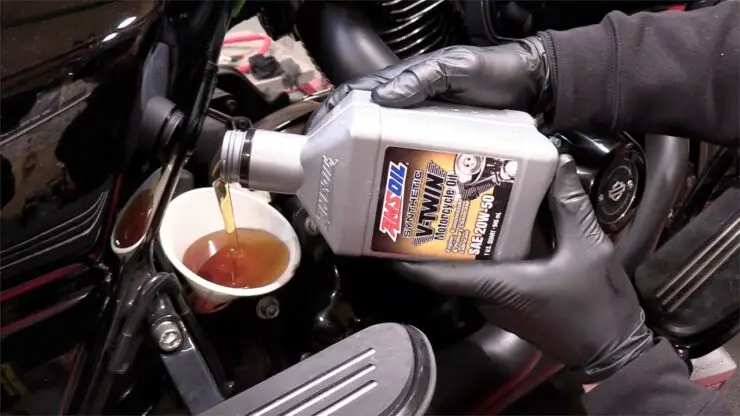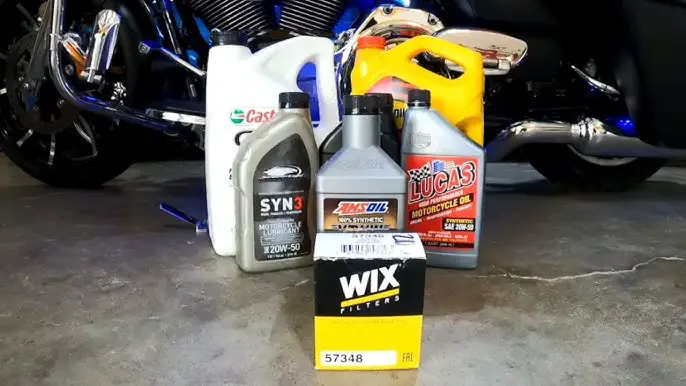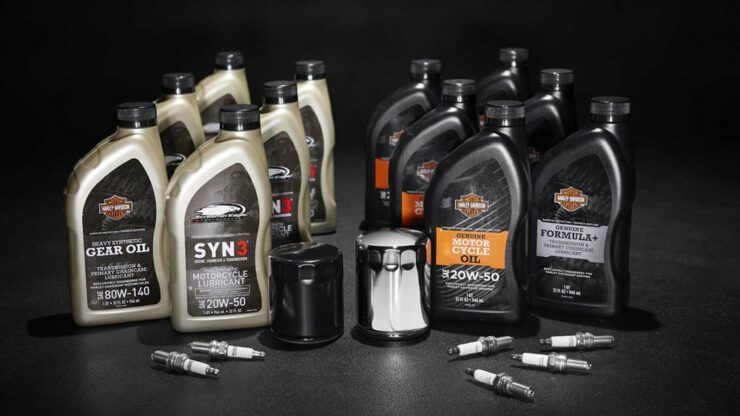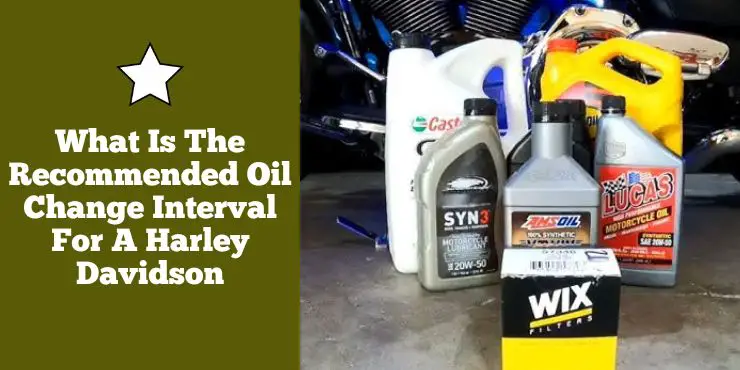Motorcycle enthusiasts know that Harley-Davidson motorcycles are built to last. But how often should you change the oil in your Harley-Davidson? The answer may surprise you!
Harley-Davidson recommends changing engine oil every 5,000 miles, or every 6 months, whichever comes first.
This article will explain the recommended oil change interval for a Harley-Davidson, as well as other key maintenance tips to keep your bike running smoothly. So, you Harley-Davidson owners out there, read on and learn how to keep your bike running at peak performance!
What is the recommended oil change interval for a Harley-Davidson?
As a Harley-Davidson rider, you will be aware of the thrill and joy of riding your Harley on the open roads and the feeling it gives. However, you wouldn’t want the feeling to get interrupted when you’re in the middle of the ride. This is why you should change the old oil and add the new one to keep your bike running smoothly. If you’re a new rider, you’ll be wondering what is the recommended oil change interval for a Harley-Davidson bike. Luckily for you, you will get the answer here.
>>> Click here to read our review of the Best Oil For Harley-Davidson <<<
For Harley-Davidson riders, it is recommended that you should change the oil in your Harley-Davidson bike once every 2,500 to 5,000 miles after the initial inspection of 1,000 miles. Meanwhile, your motorcycle can run between 5,000 to 6,000 miles using semi-synthetic oil before you need to change the oil. However, fully synthetic oil must be changed once every 7,000 to 10,000 miles.

Benefits of changing the oil in a Harley-Davidson engine regularly
Owning a Harley-Davidson bike is a dream come true for many biker enthusiasts. These iconic bikes symbolize freedom, power, and the open road. To make sure that your Harley-Davidson bike performs at its best and stands the test of time, regular maintenance will be important. One of the most important aspects of motorcycle maintenance is changing the engine oil at regular intervals. Here are some of the benefits of changing the oil in a Harley-Davidson engine regularly and how it’ll contribute to the overall performance and health of your bike.
#1. Engine lubrication and protection
The primary function of engine oil is to lubricate the moving parts of the engine. As the engine operates, metal components such as valves, pistons, and camshafts rub against each other, generating friction and heat. Regular oil changes will ensure that the oil’s lubricating properties remain effective, reducing friction and preventing wear and tear on vital engine parts. Proper lubrication will also help maintain engine efficiency and power output.
#2. Heat dissipation
Harley-Davidson engines are known for their power and performance but with that comes increased heat generation. Engine oil plays a key role in dissipating this heat. Over time, oil breaks down and becomes less effective at carrying away heat from the engine. Regularly changing the oil will ensure that it can efficiently disperse heat, preventing overheating and potential engine damage.
#3. Contaminant removal
As the engine operates, combustion by-products, dirt, and debris can find their way into the oil. Over time, these contaminants can end up compromising the oil’s effectiveness, leading to increased engine wear and reduced performance. Regular oil changes help remove these impurities, keeping the engine clean and prolonging its life.
#4. Prevention of engine sludge
When engine oil breaks down or becomes contaminated, it can result in the formation of engine sludge – a thick, sticky substance that accumulates in the engine. Engine sludge can clog oil passages, restrict flow, and impede proper lubrication. Regular oil changes help prevent the buildup of engine sludge, ensuring smooth engine operation and minimizing the risk of costly repairs.
#5. Extended engine life
By providing proper lubrication, heat dissipation, and contaminant removal, regular oil changes will contribute to extending the overall life of your Harley-Davidson engine. Well-maintaining engines are less prone to premature wear, reducing the likelihood of major engine failures and increasing the bike’s longevity.
#6. Improved fuel efficiency
A well-lubricated engine runs much more efficiently, resulting in improved fuel economy. Fresh, clean oil reduces internal friction, allowing the engine to operate with less resistance. Improved fuel efficiency will not only save you money on gas but also reduce harmful emissions, making your ride much more environmentally friendly.
#7. Compliance with warranty
For Harley-Davidson bikes still covered under warranty, regular oil changes are often a requirement for maintaining warranty compliance. Adhering to the manufacturer’s recommended oil change intervals will help you make sure that you remain eligible for warranty protection and any associated benefits.
Factors that affect oil change interval in a Harley-Davidson engine
Harley-Davidson bikes are renowned for their iconic design, powerful engines, and the thrilling experience they offer on the open road. As a Harley-Davidson rider, you’ll need to understand the importance of regular maintenance to keep your beloved machine running at its best. Among the important maintenance tasks, changing the engine oil at the right intervals is important for optimal performance and longevity. However, the ideal oil change interval can vary depending on several factors. Here are some of the key factors that affect oil change interval in a Harley-Davidson engine.
Riding conditions
One of the most pivotal factors influencing the oil change interval is the riding conditions of your Harley-Davidson motorcycle is exposed to. Frequent short trips, stop-and-go traffic, and riding in hot temperatures can put more stress on the engine, causing the oil to degrade faster. Meanwhile, long-distance highway cruising at a steady pace might result in less oil degradation. Analyzing your typical riding conditions will help determine the frequency of oil changes required.
Riding style
Your riding style can also impact the oil change interval. Aggressive riding, such as hard acceleration and high-speed riding tends to generate more heat and stress on the engine, resulting in quicker oil degradation. If you end up pushing your Harley-Davidson bike to its limits regularly, you might need to change the oil more frequently to maintain optimal engine performance.
Engine age and condition
The age and overall condition of your Harley-Davidson engine plays a major role in determining the oil change interval. Older engines tend to experience more wear and tear, leading to increased oil contamination and degradation. High-mileage engines may also benefit from more frequent oil changes to ensure continued engine protection.
Type of oil
The type of oil you are using in your Harley-Davidson engine can influence the oil change interval. Fully synthetic oils typically last longer and maintain their properties better under extreme conditions compared to conventional mineral oils. Semi-synthetic oils offer a balance between cost and performance whereas mineral oils might require more frequent changes.
Manufacturer recommendations
Harley-Davidson provides specific guidelines and recommendations regarding oil change intervals for different models. Following the manufacturer’s recommendations will help you make sure that your bike’s engine receives the appropriate maintenance for optimal performance and warranty compliance. You must consult the owner’s manual or the manufacturer’s website to find the recommended oil change intervals for your Harley-Davidson bike.
Environmental factors
Environmental conditions, such as high humidity or dusty environments can contribute to oil contamination and degradation. If you frequently ride in harsh or dusty conditions, it is advised that you should change the oil more frequently to keep the engine protected from potential damage.
Personal preference
Lastly, personal preference can also influence the oil change interval. Some riders prefer to change the oil more frequently for peace of mind and to ensure maximum engine protection. Others might stick strictly to the manufacturer’s recommendations or stretch the interval based on their riding habits and conditions.

What is the recommended oil change interval for a Harley-Davidson bike in different situations?
Harley-Davidson bikes are more than just machines that you use for traveling. They are a lifestyle and a symbol of freedom on the open road. To keep these legendary bikes roaring with power and performing at their best, regular maintenance is important. Among the most important maintenance tasks is changing the engine oil at appropriate intervals. However, the ideal oil change interval will vary depending on factors like riding style, conditions, and oil type.
Standard interval
The recommended oil change interval for Harley-Davidson bikes is once between 2,500 to 5,000 miles or once every six months, whichever comes first. The standard oil change interval is the recommended frequency for typical everyday riding conditions. It applies to riders who primarily use their Harley-Davidson bikes for casual commuting, occasional short trips, and weekend rides. The standard interval usually aligns with the manufacturer’s recommendations and is suitable for more riders who adhere to regular riding habits.
High-performance interval
For Harley-Davidson riders who enjoy spirited riding, engage in aggressive acceleration, or frequently participate in performance-oriented activities, such as group rides or track days, the high-performance interval will be more appropriate. Such riders will need to carry out the oil change once every 2,500 to 3,500 miles or every 3-4 months, whichever comes first. High-performance riding generates additional heat and stress on the engine, resulting in quicker oil degradation.
Long-distance riding interval
Harley-Davidson bikers who embark on long-distance journeys and extended tours require an oil change interval that accommodates the added stress and wear on the engine during extended rides. For such riders, they will need to get an oil change once every 2,500 to 3,000 miles or once every 2-3 months, whichever comes first. Long-distance riding often involves higher mileage in a shorter time frame, demanding a more frequent oil change schedule.
Regardless of the situation, you must refer to your Harley-Davidson bike’s owner’s manual or the manufacturer’s website for specific oil change intervals recommended for your Harley-Davidson bike model. Manufacturer guidelines take into account extensive testing and research, ensuring the best performance and longevity for the engine. Using a high-quality oil option that meets Harley-Davidson’s specifications is important for optimal engine performance and protection. You should choose the oil type (mineral, synthetic, or semi-synthetic) recommended by the manufacturer based on your budget and riding preferences.
Safety precautions to take when changing the oil in a Harley-Davidson engine
Changing the oil in a Harley-Davidson engine is an important maintenance task that ensures optimal performance and engine longevity. While this procedure is relatively straightforward, it involves working with hot oil and potential hazards that require caution and attention to safety. Whether you are a DIY Harley-Davidson enthusiast or an experienced mechanic, following proper safety precautions will be important to avoiding accidents and ensuring a smooth oil change process. Here are some of the essential safety measures that you must take when changing the oil in a Harley-Davidson bike’s engine.
Wear protective gear
Before you can start with the oil change, you must make sure that you wear the appropriate protective gear. This will include sturdy work gloves to protect your hands from hot oil and sharp edges, safety goggles or glasses for shielding your eyes from splashes or spills, and a long-sleeved shirt to prevent contact with hot engine components.
Park on a level surface
You must always park your Harley-Davidson bike on a level surface before starting the oil change. A stable and flat surface will prevent the motorcycle from tipping over during the process, reducing the risk of injuries or damage to the motorcycle.
Allow the engine to cool down
You must allow the engine to cool down before attempting to change the oil. Hot oil can result in severe burns if it comes into contact with your skin. Waiting for the engine to color will ensure a safer working environment and minimize the risk of accidental burns.
Secure the motorcycle
Before you start the oil change, you should secure the bike in an upright position using a sturdy kickstand or a motorcycle lift. Ensuring that the bike is stable and balanced will prevent it from tipping over while you work.
Use proper tools
Make sure that you have the needed tools for the oil change, such as a wrench or socket set to remove the oil drain plug and an appropriate oil filter wrench to replace the oil filter. Using the correct tools will prevent damage to the motorcycle and make the process more efficient.
Relieve pressure in the oil system
Before you remove the oil drain plug or the oil filter, relieve pressure in the oil system by starting the engine and allowing it to run for a minute or two. This step will make the oil flow much more smoothly and prevent oil spray when removing components.
Tighten the components properly
When you are reinstalling the oil drain plug and oil filter, make sure that they are tightened to the manufacturer’s recommended torque specifications. Overtightening can end up damaging the components whereas undertightening might result in leaks.
Check for potential leaks
After completing the oil change, you should start the engine and allow it to run for a few minutes. You need to check for any signs of oil leaks around the drain plug and oil filter. Address any leaks promptly for avoiding potential engine damage and maintain a safe riding experience.

How to change the oil in a Harley-Davidson engine?
Changing the oil in your Harley-Davidson bike’s engine is a vital maintenance task that ensures optimal performance and engine longevity. While it is a relatively straightforward process, it will require careful attention and adherence to specific steps. Here are the steps you need to follow for changing the oil in your Harley-Davidson bike’s engine.
Step 1: Relieve pressure in the oil system and locate the drain plug
First, you need to start the engine and allow it to run for a minute or so to warm up the oil and allow it to flow more easily during the draining process. After that, turn off the engine and allow it to sit for a couple of minutes to let the oil settle down.
After that, you need to locate the oil drain plug on the bottom of the engine. It is typically in the form of a large bolt or plug, typically located towards the front or side of the engine’s oil pan.
Step 2: Position the catch pan
Next, you will need to place the catch pan directly under the oil drain plug for collecting the old oil when it is drained from the engine. Make sure that the catch pan is big enough to hold the entire volume of oil.
Step 3: Remove the oil drain plug and drain the old oil
With the help of a wrench or socket set, you should carefully loosen and remove the oil drain plug. Be extremely cautious as the oil could be hot.
Allow the old oil to drain completely into the catch pan. This process could take a few minutes. You should make sure that you catch all the oil to prevent any spills and environmental contamination.
Step 4: Remove and replace the oil filter
Next, you should locate the oil filter on the engine. Depending on your Harley-Davidson model, the oil filter might be exposed or hidden behind a cover. Make use of an oil filter wrench for carefully loosening and removing the old oil filter.
Step 5: Prepare the new oil filter and install it
Before you install the new oil filter, apply a thin layer of fresh oil to the rubber gasket on the new filter. This will help in creating a proper seal and prevent any leaks.
Carefully thread the new oil filter onto the engine by hand. Once it has been hand-tightened, make use of an oil filter wrench to give it an additional quarter turn to secure it properly. Be cautious that you do not overtighten the filter.
Step 6: Replace the old drain plug
Once the old oil has drained completely, clean the old drain plug before reinstalling it into the oil pan. Then, tighten the plug to the manufacturer’s specified torque settings.
Step 7: Add new oil
Refer to your Harley-Davidson bike’s owner’s manual for the recommended type and amount of engine oil. Typically, Harley-Davidson recommends that riders should go for options like the OEM ones that are sold by the brand itself. Alternatively, you can also go for aftermarket options like the Mobil 1 20W-50 V-twin synthetic motorcycle motor oil. Using a funnel, you should pour the new oil into the engine through the oil filler cap.
Step 8: Check the oil level
Once you have added the new oil, you should wait a few minutes so that it can settle down. After that, check the oil level using the dipstick or sight glass, depending on your bike’s model. Adjust the oil level as required.
Step 9: Start the engine and check for leaks
Start the engine and allow it to run for a few minutes to circulate the new oil. While the engine is still running, you should check for any signs of oil leaks around the drain plug and oil filter. If you find any leaks, you should address them promptly.
Step 10: Dispose of used oil properly
Properly dispose of the used oil by taking old oil to a recycling center or an automotive shop that accepts used motor oil for recycling. You shouldn’t be pouring used oil down the drain or into the ground as it can be harmful to the environment.
FAQ
What is the recommended oil change interval for a Harley-Davidson motorcycle?
Harley-Davidson recommends changing the oil in your motorcycle every 2,500 to 5,000 miles, depending on the type of oil used and the operating conditions. It is important to follow the manufacturer’s recommended oil change interval to keep your engine running smoothly and efficiently.
What type of oil should be used for a Harley-Davidson?
Harley-Davidson recommends using a high-quality SAE 20W-50 or 10W-40 motorcycle oil for four-stroke engines. Synthetic or semi-synthetic oils are also recommended for optimal performance.
What are the benefits of changing the oil in a Harley-Davidson?
Regularly changing the oil in your Harley-Davidson provides several benefits, including improved engine performance, reduced wear and tear, and improved fuel economy. Keeping the oil clean also helps protect the engine from dirt, debris, and other contaminants that can cause engine damage.
>>> Read more about Oil for Harley-Davidson <<<

